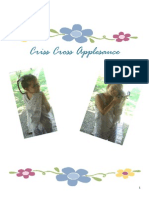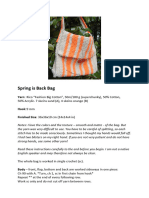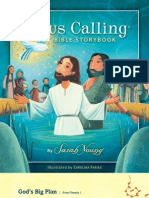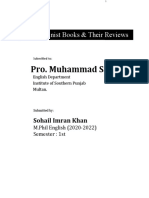0 ratings0% found this document useful (0 votes)
130 views1basic PDF
1basic PDF
Uploaded by
Luciana FerreiraThis document provides instructions for binding a book using the Crossed Structure Binding Basic (CSB Basic) technique. It describes:
1) Cutting the covers into two asymmetric pieces, sides A and B, with an even number of straps on one side and an uneven number on the other.
2) Two methods for sewing the book block to the covers - Sewing 1 attaches the book block to side A, while Sewings 2 & 3 attach to side B and include structural headband cores.
3) "Crossing" the straps of each cover piece to interlock them at the spine once sewing is complete.
Copyright:
© All Rights Reserved
Available Formats
Download as PDF, TXT or read online from Scribd
1basic PDF
1basic PDF
Uploaded by
Luciana Ferreira0 ratings0% found this document useful (0 votes)
130 views5 pagesThis document provides instructions for binding a book using the Crossed Structure Binding Basic (CSB Basic) technique. It describes:
1) Cutting the covers into two asymmetric pieces, sides A and B, with an even number of straps on one side and an uneven number on the other.
2) Two methods for sewing the book block to the covers - Sewing 1 attaches the book block to side A, while Sewings 2 & 3 attach to side B and include structural headband cores.
3) "Crossing" the straps of each cover piece to interlock them at the spine once sewing is complete.
Original Title
1BASIC.pdf
Copyright
© © All Rights Reserved
Available Formats
PDF, TXT or read online from Scribd
Share this document
Did you find this document useful?
Is this content inappropriate?
This document provides instructions for binding a book using the Crossed Structure Binding Basic (CSB Basic) technique. It describes:
1) Cutting the covers into two asymmetric pieces, sides A and B, with an even number of straps on one side and an uneven number on the other.
2) Two methods for sewing the book block to the covers - Sewing 1 attaches the book block to side A, while Sewings 2 & 3 attach to side B and include structural headband cores.
3) "Crossing" the straps of each cover piece to interlock them at the spine once sewing is complete.
Copyright:
© All Rights Reserved
Available Formats
Download as PDF, TXT or read online from Scribd
Download as pdf or txt
0 ratings0% found this document useful (0 votes)
130 views5 pages1basic PDF
1basic PDF
Uploaded by
Luciana FerreiraThis document provides instructions for binding a book using the Crossed Structure Binding Basic (CSB Basic) technique. It describes:
1) Cutting the covers into two asymmetric pieces, sides A and B, with an even number of straps on one side and an uneven number on the other.
2) Two methods for sewing the book block to the covers - Sewing 1 attaches the book block to side A, while Sewings 2 & 3 attach to side B and include structural headband cores.
3) "Crossing" the straps of each cover piece to interlock them at the spine once sewing is complete.
Copyright:
© All Rights Reserved
Available Formats
Download as PDF, TXT or read online from Scribd
Download as pdf or txt
You are on page 1of 5
CROSSED STRUCTURE BINDING BASIC
Asymmetry as the absence of formal equilibrium of the parts,
around an idea univocal and clear.
Gian Carlo Calza
CSB Basic shall explain both
I will assume that the book is alternatives because they
ready to be bound and that all imply different patterns of
prior steps have been sewing.
carefully carried out. The For the fixing of the cover to
description refers to a full- the sewing frame, see image in
leather binding with clean-cut the website: Index - A Sewing
edges (handmade paper, Frame - CSB Basic.
parchment and vellum can also
be used). I will not work to Sewing 1
any particular dimension, The book-block is sewn to the
assuming the template to be three central straps of CSB
clear enough for each person Basic side a (see template).
to adapt it to a given size. The sewing is carried out with
kettle stitches in the normal
The cutting way (see Sewing 1). After
Asymmetry is a constant sewing, the spine is still
feature on all Crossed accessible and can be lined if
Structure bindings. desired. The thickness of the
The two parts of the CSB Basic thread should provide enough
are complementary and swell in the spine to allow
asymmetric. The number of you to round the book. I
straps will be even on one
always round by hand, not with
side and uneven on the other.
a hammer.
The two parts of this cover
are cut in just one go, each Sewing 2
one fitting perfectly in its This sewing is carried out on
counterpart. This feature
the four straps of CSB Basic
belongs only to the basic
side b (see template). In this
form; any other crossed
case the first and the last
structure has to be cut in two
strap become structural
separate pieces.
headband cores. This will add
For the cutting of the straps
see images in the website: solidity and support to the
Index - Cutting the straps. spine and will allow smooth
Cut the covers following sides opening even with heavy
a and b of the template (see volumes (see Sewings 2 & 3).
template). The two parts
include the cover itself and
The crossing
the bands both for the sewing After sewing, the straps of
and for the crossing. the two covers interlock at
the spine and can be secured
The sewing to the opposite side. See the
The sections can be sewn to bindings image in the
either half of the cover. I website: Index - CSB Basic.
Crossed Structure Binding Basic by Carmencho Arregui - www.outofbinding.com 1
TEMPLATES
SEWING 1
WITH KETTLE STITCHES.
FOR CSB BASIC, CSB PROTECTIVE, CSB MARCOPOLO AND CSB HIDDEN
This is the commonest kind of left, passing out and in the
sewing and the first that the section and over the straps
majority of us learned how to until the left end is reached.
make, as it can be used for It comes out at the kettle
many different bindings. The stitch hole on the left and
thing to be careful about, if goes up into the next section.
you are a beginner, is never
to pull the thread in the Second section
opposite direction to the The thread goes inside the
direction in which you are kettle stitch hole on the
sewing, because it is quite left, then it goes to the
easy to tear the paper. Try to right, out and in all along.
be as even as possible and do It goes out at the right hand
the stitches neither too tight kettle stitch hole. Before
nor too loose. It all comes going up to the third section
with practice. After 500 books a knot is tied with the tail
it will be almost perfect! of the starting thread which
is hanging from the first
Sewing 1 section.
See drawing and follow the
direction of the red thread, Third section
then compare the image with The thread goes inside the
your finished sewing. kettle stitch hole on the
Here follows a very schematic right and then it goes to the
description. left, out and in all along. It
goes out at the kettle stitch
First section hole on the left. Before going
The thread goes into the first up to the following section a
hole on the right (kettle kettle stitch is made by
stitch hole), and then travels slipping the needle under the
Crossed Structure Binding Basic by Carmencho Arregui - www.outofbinding.com 2
section which is below the one behind the thread in the same
which you have just sewn on; direction as the direction in
slip the needle behind the which you are sewing (usually
thread which links it to the outwards, towards the edge of
section below that, and loop the book-block.)
the thread over the needle as From this point the sewing
it emerges from between the goes on in the same way,
sections. Tighten the thread making kettle stitches at each
by tugging it upwards. NB The section before going up to the
needle must always be slipped next one.
sewing 1
kettle
stitch
knot
Crossed Structure Binding Basic by Carmencho Arregui - www.outofbinding.com 3
SEWINGS 2&3
WITH HEAD AND TAIL SEWN STRAPS.
FOR CSB BASIC AND CSB PROTECTIVE.
Sewing 2 section a knot is tied with
See drawing and follow the the tail of the starting
direction of the red thread, thread which is hanging from
then compare the image with the first section.
your finished sewing.
Here follows a very schematic Third section
description. The thread goes into the first
hole on the right, close to
First section the right-hand strap,
The thread goes into the first encircles the strap, goes back
hole on the right, close to into the same hole as before,
the right-hand end strap, and goes out and in to the
comes out at the end of the left.
section, passes over the top The thread comes out before
of the section, encircling the the last strap, goes over it,
strap and goes back into the goes back into the section and
same hole as before (each time comes out at the same hole.
you go back through the same Before going up to the next
hole, be careful not to go section a kettle stitch is
through the thread when made by slipping the needle
inserting the needle). under the thread you have just
The thread then travels left, sewn around the strap and also
passing out and in the section catching up the thread at the
and over the other straps same point in the section
until the end strap is below the one which you have
reached. The thread comes out just sewn on. The needle then
before the last strap, passes goes back up and under the
over the top of the section to thread that emerges from the
encircle the strap and emerges upper section, making a
through the same hole. The loop.(NB The needle must be
second section is laid in slipped outwards, towards the
place. edge of the book-block).
Tighten the thread by tugging
Second section it upwards to make the
The thread goes into the first characteristic pattern that
hole on the left, close to the you can see in the image
left-hand end strap. Comes out above.
at the end of the section, From this point the sewing
passes over the top of the goes on in the same way,
section, encircling the strap making kettle stitches at each
and goes back into the same section before going up to the
hole as before. The thread one above.
goes to the right, out and in
all along. It goes out at the Sewing 3
last hole and out again after See drawing and follow the
encircling the right-hand direction of the red thread,
strap. then compare the image with
Before going up to the third your finished sewing.
Crossed Structure Binding Basic by Carmencho Arregui - www.outofbinding.com 4
Seen from the outside there is thread running over head and
no difference between Sewing 2 tail edges as well. It keeps a
and 3. The process is as consistent swell along the
before but this time the volumes spine and can be a
thread encircles each strap. good choice for larger or
This gives an all-along sewing heavier books.
sewing 2
inside each section, with the
kettle
stitch
knot
sewing 3
kettle
stitch
knot
Crossed Structure Binding Basic by Carmencho Arregui - www.outofbinding.com 5
You might also like
- The Closer - Ben Gay IIIDocument311 pagesThe Closer - Ben Gay IIIirish_stud100% (9)
- Bare Bones: A Novel by Kathy ReichsDocument13 pagesBare Bones: A Novel by Kathy ReichsSimon and Schuster80% (20)
- Planking PrimerDocument8 pagesPlanking PrimermouradNo ratings yet
- Rakusu Instructions 2007 PDFDocument13 pagesRakusu Instructions 2007 PDFEverest HimalaiaNo ratings yet
- Mini Mandala Garland Overlay Crochet PatternDocument8 pagesMini Mandala Garland Overlay Crochet PatternHomoki Gabriella100% (3)
- Book Club Guide: Side Effects May VaryDocument1 pageBook Club Guide: Side Effects May VaryEpicReadsNo ratings yet
- 16 Stitches To Learn: An Essential Step-By-Step Guide To Mastering 16 Embroidery Stitches To Enhance Your Sewing ProjectsDocument10 pages16 Stitches To Learn: An Essential Step-By-Step Guide To Mastering 16 Embroidery Stitches To Enhance Your Sewing Projectssorayasabera100% (4)
- Guia de PuntosDocument23 pagesGuia de PuntosL31p24100% (3)
- Quiver Sewing PatternDocument9 pagesQuiver Sewing PatternLas 3carNo ratings yet
- Beginners Kit Sculpture Instructions: Cut Connect Create!Document10 pagesBeginners Kit Sculpture Instructions: Cut Connect Create!aNo ratings yet
- Corset Belt Sew AlongDocument10 pagesCorset Belt Sew AlongBrenna Wolfe100% (1)
- 12 226 Shirt Collar PointersDocument2 pages12 226 Shirt Collar Pointersattah4789100% (1)
- Battie Treat Bag: A Sewing Pattern byDocument11 pagesBattie Treat Bag: A Sewing Pattern byAlice WCMNo ratings yet
- 3-Needle Bind Off - Purl Soho - Beautiful Yarn For Beautiful KnittingDocument3 pages3-Needle Bind Off - Purl Soho - Beautiful Yarn For Beautiful KnittingEva TuáNo ratings yet
- U2-02 - Flat and Embossed Stitch Guide - ENDocument4 pagesU2-02 - Flat and Embossed Stitch Guide - ENJohanna JimenezNo ratings yet
- Fix Your Patterns Before You SewDocument6 pagesFix Your Patterns Before You SewLouti Khadr100% (2)
- 8 Period StitchesDocument11 pages8 Period StitchesNatalia Bohle100% (1)
- Instructions For Beading Basic Square Stitch: StartingDocument3 pagesInstructions For Beading Basic Square Stitch: StartingMMNo ratings yet
- Caterpillar Book Binding: A Quick Guide To Preparing Your Boards and SignaturesDocument8 pagesCaterpillar Book Binding: A Quick Guide To Preparing Your Boards and SignaturesDaniella ZapataNo ratings yet
- Definition of Terms: Learning OutcomesDocument7 pagesDefinition of Terms: Learning OutcomesMichelle DadiosNo ratings yet
- Chain Chomp Plush Sewing PatternDocument14 pagesChain Chomp Plush Sewing PatternDaiko Coronell100% (1)
- Totoro Bag Sewing PatternDocument17 pagesTotoro Bag Sewing PatternRoberta AndiNo ratings yet
- Criss Cross Applesauce Instructions FinalDocument10 pagesCriss Cross Applesauce Instructions FinalCrystal CarterNo ratings yet
- Embroidery BasicsDocument8 pagesEmbroidery BasicsRanil Hashan F100% (2)
- Fix Your Patterns Before You SewDocument6 pagesFix Your Patterns Before You Sewxhoyp2ko6No ratings yet
- Babt Bonnet PatternDocument5 pagesBabt Bonnet PatternAnne JennisonNo ratings yet
- Small PouchDocument4 pagesSmall PouchkvmendozaNo ratings yet
- Module 4 Lesson 3Document8 pagesModule 4 Lesson 3Trisha Marie Nalla TallodarNo ratings yet
- Autumn Adagio Beaded Lace Shawl v1Document7 pagesAutumn Adagio Beaded Lace Shawl v1Joelle SwysenNo ratings yet
- Sewing Pattern of The Three Pocketed Quilted HandbagDocument27 pagesSewing Pattern of The Three Pocketed Quilted Handbagmanolimurillo71No ratings yet
- Matching Cast Ons and Bind Offs, Part 1: Six Pairs of Methods that Form Identical Cast On and Bind Off Edges on Projects Knitted Flat and in the RoundFrom EverandMatching Cast Ons and Bind Offs, Part 1: Six Pairs of Methods that Form Identical Cast On and Bind Off Edges on Projects Knitted Flat and in the RoundNo ratings yet
- TE-04043 Introduction To Knitting Technology (Sample Answer)Document7 pagesTE-04043 Introduction To Knitting Technology (Sample Answer)Ashraful HimelNo ratings yet
- Tutorial How To Make A Basic Ribbon CorsetDocument20 pagesTutorial How To Make A Basic Ribbon CorsetBianca von Teese100% (1)
- Making A Collar With A StandDocument2 pagesMaking A Collar With A StandCallieNo ratings yet
- Las Tle9 Handicraft Embroidery Wk3 7 McentinaDocument21 pagesLas Tle9 Handicraft Embroidery Wk3 7 McentinaChloe CrisostomoNo ratings yet
- Scrub Cap For Men and WomenDocument9 pagesScrub Cap For Men and WomenDetsyta JadanNo ratings yet
- Dfav 7 HMDocument10 pagesDfav 7 HMcecilia davisonNo ratings yet
- Skjoldehamn Hood TutorialDocument4 pagesSkjoldehamn Hood TutorialintuitionNo ratings yet
- Different Types of NecklineDocument11 pagesDifferent Types of NecklinesampleuNo ratings yet
- Quilt As You Go Train Case Sewing PatternDocument19 pagesQuilt As You Go Train Case Sewing PatternJoltickle100% (3)
- The Bayeux StitchDocument5 pagesThe Bayeux Stitchtinal999100% (1)
- Goldwork TechniquesDocument15 pagesGoldwork Techniquesjeanada phillips100% (2)
- Knitted Christmas Baubles: by Suzanne StrachanDocument4 pagesKnitted Christmas Baubles: by Suzanne StrachanMARIANo ratings yet
- 50 Shades of Stitches - Classic & Contemporary Knitting Patterns: Volume 2, #2From Everand50 Shades of Stitches - Classic & Contemporary Knitting Patterns: Volume 2, #2No ratings yet
- Spring Is Back BagDocument3 pagesSpring Is Back BagristaaprianiNo ratings yet
- Ruffl Ed Collar PatternDocument1 pageRuffl Ed Collar PatternSarang KimNo ratings yet
- U3 ADJ 03 PunchNeedleMiniManualDocument12 pagesU3 ADJ 03 PunchNeedleMiniManualLaurita CaballeröNo ratings yet
- Learn To KnitDocument6 pagesLearn To Knitraluca.colgiu4622No ratings yet
- That Side Plus The Leather ThicknessDocument5 pagesThat Side Plus The Leather ThicknessKenBeckettNo ratings yet
- Cassini Crescent ShawlDocument8 pagesCassini Crescent ShawlMARIANo ratings yet
- What Are Basic Pattern Blocks and How To Use ThemDocument29 pagesWhat Are Basic Pattern Blocks and How To Use ThemElla ShteynbergNo ratings yet
- The Doveport CardiganDocument26 pagesThe Doveport CardiganMarie-Eve AllardNo ratings yet
- Beleaf in Yourself: The Nerd KnitsDocument13 pagesBeleaf in Yourself: The Nerd KnitsAndreea Antohi100% (1)
- Noro Bias Lace Final - March 4thDocument6 pagesNoro Bias Lace Final - March 4thAdele SaittaNo ratings yet
- Houndstooth_Headband_ENDocument3 pagesHoundstooth_Headband_ENpolkadocNo ratings yet
- Stitch Types - EmbroideryDocument10 pagesStitch Types - EmbroideryAredaNo ratings yet
- HOW TO QUILT AS YOU GO: The essential step by step guide to learn the skills, techniques and new patterns to produce stunning Quilt projects witFrom EverandHOW TO QUILT AS YOU GO: The essential step by step guide to learn the skills, techniques and new patterns to produce stunning Quilt projects witNo ratings yet
- The Top 10 Hand Embroidery Stitches Every Beginner Should LearnDocument1 pageThe Top 10 Hand Embroidery Stitches Every Beginner Should LearnIsma AzmiNo ratings yet
- Basic Stitches in Symbols and AbbreviationsDocument18 pagesBasic Stitches in Symbols and AbbreviationsLyn Jealou AbastillasNo ratings yet
- Poetry PDFDocument36 pagesPoetry PDFhNo ratings yet
- The Picture of Dorian GrayDocument9 pagesThe Picture of Dorian GrayAfsheen Danish NaqviNo ratings yet
- WILLIUM H Automotive BookDocument435 pagesWILLIUM H Automotive Bookrahul jainNo ratings yet
- Lady in Gold 1Document9 pagesLady in Gold 1api-384670127No ratings yet
- Foundations For Industrial Machines: Handbook For Practising EngineersDocument1 pageFoundations For Industrial Machines: Handbook For Practising EngineerssrieeNo ratings yet
- Easier Than Falling Asleep - JacobApplesDocument424 pagesEasier Than Falling Asleep - JacobApplessikit36318No ratings yet
- 2015.282052.the Cambridge TextDocument877 pages2015.282052.the Cambridge TextJuan Pablo López Barroso100% (1)
- Group 6 (Jennifer Tesalonika Erick) - Comparing Introducing Self & Others vs. Biography & Autobiography - Similarities & Differences, Etc.Document5 pagesGroup 6 (Jennifer Tesalonika Erick) - Comparing Introducing Self & Others vs. Biography & Autobiography - Similarities & Differences, Etc.Jennifer Tesalonika ErickNo ratings yet
- NamaputunDocument3 pagesNamaputunrain.holt57No ratings yet
- The Foundation of Our Faith 6th EditionDocument274 pagesThe Foundation of Our Faith 6th EditionElinaldo Soares Costa SilvaNo ratings yet
- Jesus Calling Bible StorybookDocument15 pagesJesus Calling Bible StorybookThomasNelson83% (12)
- Foucault On Don QixoteDocument3 pagesFoucault On Don QixoteMedway08No ratings yet
- 201 Giao Trinh Thu Tin Trong TMQT 2003Document84 pages201 Giao Trinh Thu Tin Trong TMQT 2003Vinh Béo100% (1)
- Elizabeth Barrett Browning 22Document20 pagesElizabeth Barrett Browning 22Donna Mae Fadollone TironNo ratings yet
- FINAL-Strategic Plan, Part II - SWOTT Analysis-Asa010879Document12 pagesFINAL-Strategic Plan, Part II - SWOTT Analysis-Asa010879melton23No ratings yet
- Dīrghatamas, An Application of The Generalization of Witzel's GridDocument15 pagesDīrghatamas, An Application of The Generalization of Witzel's GridforizslNo ratings yet
- Kali Bang AnDocument9 pagesKali Bang AnayandasmtsNo ratings yet
- 'Princesses Are Not Into War 'N Things, They Always Scream and Run Off': Exploring Gender Stereotypes in Picture BooksDocument7 pages'Princesses Are Not Into War 'N Things, They Always Scream and Run Off': Exploring Gender Stereotypes in Picture BooksKatia KouzelisNo ratings yet
- Bookreportq3 2016-AngelieferncrisbaliosDocument2 pagesBookreportq3 2016-Angelieferncrisbaliosapi-302648473No ratings yet
- Sobotta Atlas of Anatomy, Vol. 1: General Anatomy and Musculoskeletal System (English/Latin) (16th Ed.) 16th Edition Friedrich PaulsenDocument64 pagesSobotta Atlas of Anatomy, Vol. 1: General Anatomy and Musculoskeletal System (English/Latin) (16th Ed.) 16th Edition Friedrich Paulsenorawebasoma6100% (4)
- Author William D. Rose's New Book, "Pop Smoke or The Colonel in The Helicopter," Is A Collection of Leadership Insights Gleaned by The Author During His Military CareerDocument4 pagesAuthor William D. Rose's New Book, "Pop Smoke or The Colonel in The Helicopter," Is A Collection of Leadership Insights Gleaned by The Author During His Military CareerPR.comNo ratings yet
- Azazel in Early Jewish TraditionDocument10 pagesAzazel in Early Jewish TraditionShep SmithNo ratings yet
- The Big Picture Issue 20Document25 pagesThe Big Picture Issue 20Intellect Books100% (2)
- A Comparison of Reader Response Theory and Formalist CriticismDocument3 pagesA Comparison of Reader Response Theory and Formalist CriticismSohail KhanNo ratings yet
- Unthinking The Greek Polis Ancient GreekDocument11 pagesUnthinking The Greek Polis Ancient GreekSatvik M.No ratings yet
- Words in Action - Unit 2Document4 pagesWords in Action - Unit 2Christopher RamosNo ratings yet
- The Wedding Dance by Amador TDocument3 pagesThe Wedding Dance by Amador Tkheymi100% (1)

























































































